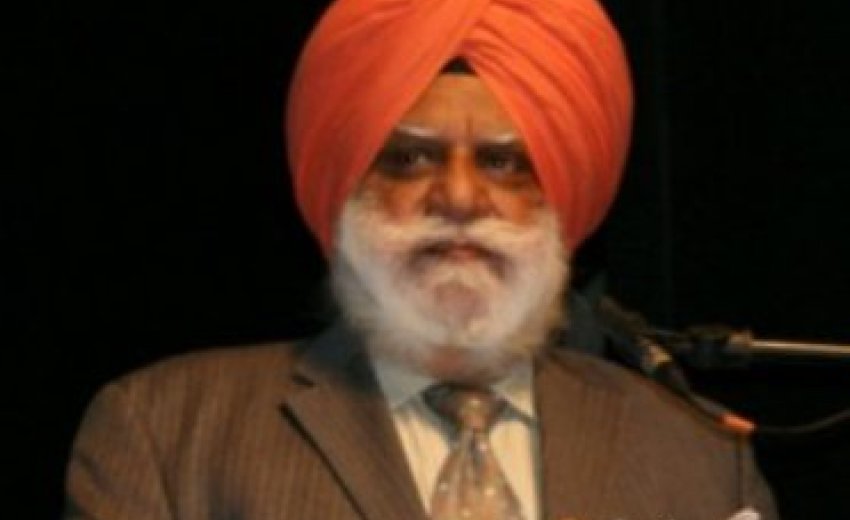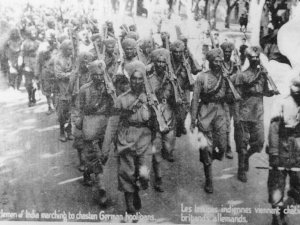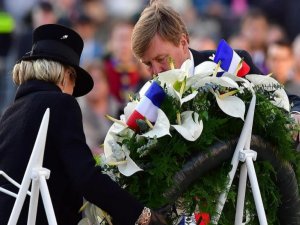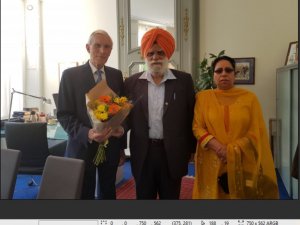Role of British Indian Soldiers in World War 1 (1914-1918)
Bhupinder Singh Holland
https://www.facebook.com/bhupindersingh.holland
Today, on the invitation of British Organization for People of Asian Origin ( BOPA ), we have gathered here in Belgrade Theatre, Coventry to commemorate and to raise awareness about brave & mostly forgotten contribution of British Asians to British Society that we now live in.
We are proud that British Asians has helped the international Community twice in the 20th Century by fighting alongside with the allied forces of Great Britain, USA, France, Belgium, Canada, Australia and other Countries to preserve peace and freedom in the world. They have died in large numbers for all of us for our freedom and better future. We now live with dignity, honor and pride. The whole world owes them a lot as their supreme sacrifices has brought democracy, freedom of speech and identity.
As soon as the war broke out in early August 1914, both British and the French were mobilizing their respective empires. Soldiers and laborers from all over the world were brought to the Western Front (France and Belgium.) More than 30 different nationalities were engaged in the Ypres Salient.
When we talk about Nations, we should not forget for instance, Belgian includes Walloons and Flemings, French includes Bretons, Occitan's and Flemings, who were often unable to speak or understand French. The British includes of course, English, Scots, Welsh, Irish, Channel Islanders, and I might have even forgotten some.
In the French Army, one would find Moroccan, Algerian, Tunisian, Senegalese, other West Africans, and troops from French Guyana as well as laborers from Indochina - the Ammonites.
The British, however, undoubtedly disposed of the world's greatest empire in 1914. Firstly, there were the Dominions; Canada, Australia, New Zealand and South Africa in addition to the crown colonies of Newfoundland and Even some smaller constituent parts of the British Empire sent their sons to Western Front as, Egypt (Egyptian Labor Corps), BWI (the Caribbean and mainly Jamaica, Trinidad & Tobago and Barbados) and Bermuda, the Fiji Islands (Fijian Labor Corps). Then again, the British army itself counted amongst their ranks white Rhodesians. I have restricted the list to those nationalities whose presence in Flanders during the Great War is undeniably proven by evidence of written documents, testimonials or material and facts.

Now I come to, of course, our main subject of today British Asians in World War 1.
When we speak of Indians in this text we refer to the inhabitants of the Crown Colony of India that belonged to the British Empire. The official name was the British Indian Empire, or also occasionally the British Raj. It was ruled by its own government under the leadership of a Viceroy, representing the British monarch, who used the title of 'Emperor' in this context. In practice the British governed with the help of the Indian aristocracy: tens of princes, maharajahs and other monarchs. British India comprised the present day states Pakistan, India, Bangladesh and Burma (Myanmar). The kingdoms of Nepal and Bhutan were independent, but treaties allowed the British to be very influential. The Indian national leaders supported the British with money and manpower.
Tamil community also contributed to war. In 1915, the Tamils in Malaya organized an All Ceylon Tamil Fund and presented on 22nd December 1915 a fighter plane named Jaffna to the British Government. This is evident from a letter written on April 27, 1916 by Right Hon. Andrew Bonar, Law Secretary of State for Colonies appreciation of the patriotic spirit shown by the JAFFNA TAMILS FROM CEYLON in subscribing for the Aeroplane out of their comparatively small resources.
The Indian army reported to the British-Indian government, but on the Western Front the Indian Army Corps and the Indian Labour Corps de facto came under British military authority. The Indian army was organized in a similar way as the British, although there were some significant differences. For instance, it had its own military law. With the exception of a few regiments, each Indian regiment only comprised 1 battalion of some 750 men. An Indian infantry division was composed of three brigades with four battalions, one of which was always British. Ethnically mixed battalions, like the 57th Wilde's Rifles (with Sikhs, Dogras, Pathans and Punjabi Muslims) fought alongside ethnically homogenous battalions, like the 47th Sikhs (Sikhs only).
There were two types of officers: British and Indian. The British ranked higher than the Indian. The highest ranks had the same name as the British, but they also had a few specific ranks like subadar (similar to a captain) or jemadar (similar to a British lieutenant). The non-commissioned officers (N.C.O.s) always used Indian denominations like havildar (sergeant) or naik (corporal). A private was a sepoy (cf. British private). The cavalry had other specific ranks like rissaldar, woordie-major, kot-daffadar, daffadar, etc. A cavalry soldier was a sowar, equivalent to a British 'trooper'.
Although the Indian army of 1914 did not reflect the colourful ethnic mix of the subcontinent, it was a melting pot of cultures, peoples and communities, each with its own characteristics and customs.
The story of the Indian army on the Western Front started on 6 August 1914. That day the War Council asked the Indian government to dispatch two infantry divisions and one cavalry brigade to Egypt. The two selected infantry divisions were the Lahore Division and the Meerut Division. Together they constituted the Indian Army Corps. They were later reinforced with the Secunderabad Cavalry Brigade. On 27 August 1914, the British government decided to send the Indian divisions straight to France to back up the British Expeditionary Force that had suffered heavy losses near Mons. At the end of September 1914 the Lahore Division arrived in Marseille under loud cheers of the local population, a fact that was ridiculized by the Germans in their propaganda. Only one brigade, the Ferozepore Brigade, was at full strength because the other units had not yet left India or had been delayed near Suez. Marseille must have offered a very colourful sight as the French colonial troops also usually disembarked in this port. Marseille would remain the Indian 'base port' throughout the 14 months during which the Indian army corps was in Europe.
The people who lived in the Indian subcontinent had been divided into martial and non-martial ethnic groups by the British in compliance with the racist 'martial races theory'. A 'martial race' was considered brave and well-built for fighting but also less intelligent. According to the British a non-martial race was unsuitable as a soldier because of his sedentary lifestyle, build or attitude. Soldiers in the British Indian army were recruited among the martial races. The theory offered numerous advantages for the British rulers: it created a competitive spirit among the various ethnic groups that suited their divide-and-rule policy. Moreover, this theory made the intellectuals and those with a higher education look like non martial, whereas the uneducated and less developed were presented as being brave. Ethnic groups from the plains and from East India were generally considered as 'non-martial'. The Sikhs from Punjab (Northern India/Pakistan) were considered to be the prime 'martial race'. The Gurkhas from Nepal and Northern India are also a famous 'fighting race' and still have an elite unit within the British army. Other martial races were the Baloch (from South West Pakistan), the Dogra (from Jammu, Northern India), Garhwalis (from Uttarakhand, in the Himalaya), Jats (from Rajasthan and Punjab), Pathans or Pashtuns (from the border region between Pakistan-Afghanistan: North West Frontier Province), Rajputs (a community of Hindu fighters in Northern India). Dalits were recruited in large numbers and the famous 34 Sikh Pioneers ( Ambala ) were only from Ravidasia's and Majabhi Sikhs.
It is also important to emphasize the very particular relationship that existed between the British officers, their Indian NCOs and the rank and file. The British officers did speak the local languages and the relationship towards the Indian troops they were commanding is best described as paternalistic. There are numerous accounts of mutual respect from the officers towards the Indians and vice versa.
A British Indian infantry division was composed of three brigades with four battalions (after the battle of Neuve-Chapelle in April 1915, five battalions). One of these four battalions was British, among other reasons as an element of controlling the Indian troops. A British Indian battalion consisted in theory of 13 officers and 750 rank and files - less than its British counterpart.
To elaborate my point, I will give you here the composition of some of the Regiments belonging to Lahore Division.
9th Bhopal Infantry (-): 2 Sikhs, 2 Rajputs, 2 Moslims, 2 Brahmins
15th Ludhiana Sikhs (Multan): 8 Sikhs
34th Sikh Pioneers (Ambala): 8 Mazbi en Ramdasia Sikhs
40th Pathans (Sialkot): 2 Orakzais, 1 Afridis, 1 Yusufzais, 2 Dogras, 2 Punjabi Moslims
47th Sikhs (Rawalpindi): 8 Sikhs
57th Wilde's Rifles (Dera Ismail Khan): 2 Sikhs, 2 Dogras, 2 Punjabi Moslims, 2 Pathans
59th Scinde Rifles (Kohat): 3 Pathans, 2 Sikhs, 1 Punjabi Moslims, 2 Dogras
125th Napier's Rifles (Nasirabad): 4 Rajputana Jats, 2 Rajputana Rajputs, 2 Punjabi Moslims
129th D. of C.'s Own Baluchis (Karachi): 2 Punjabi Moslims, 3 Mahsuds, 3 other Pathans
15th Lancers (Cureton Multanis): 4 eskadrons Multani Pathans and Moslims from the Dejarat and Cis-Indus.
Many British Regiment fought along with British Indian Army. I shall give you some examples
1stConnaughtRangers(Brits), 1st Manchesters (Brits), 1st Highland Light Infantry (Brits), 4th London (Brits), 4th Suffolks (Brits), 4th (King's) Liverpool Regt (Brits), Royal Leicestershire Regiment, also known as "The Tigers and many more.
On its way to France, the Lahore Division left one of its brigades near the Suez Canal, and, as some units of the Jullundur Brigade only left India by the end of September, it was only the Ferozopore Brigade that was at its full strength.
For the British Indian troops, Europe was a totally new and a strange experience. They did not understand the language and were not understood and their culture was completely different. The Indians and the French or the Belgians looked upon one another with strange eyes. Nevertheless, the Indians were well received by the French population.
Sikh soldiers of 15th Sikh regiment ( Multan ) landed in Marseilles -France on the 26th of September 1914 for the 1st time.
From Marseilles the Indian troops went north, over Orleans. When the 47th Sikhs were moving up to the front, they were billeted in a large monastery near Saint-Omer on 20th October 1914 and were well received by the monks. However, the curious troops continually scrutinized the statues of the twelve apostles in the main corridor of the abbey. Finally, they accepted their British officers' explanation that these were images of Christian gurus!
Belgium :
On 22nd October 1914, the Ferozepore Brigade arrives in the "new-born" Ypres Salient. They are sent to the trenches between Hollebeke in the north and Messines in the south. That was 8 km long. At Hollebeke, 1st action took place against Germany and 57th Wilde's Rifles (Dera Ismail Khan): 2 Sikhs, 2 Dogra Sikhs, 2 Punjabi Moslims, 2 Pathans.
To mark this historical event, there stands now a "Monument of the British Indian Army", built by City of Ieper and inaugurated by Panj Piaras on 3rd of April 1999 to remember the 3rd Century of the revelation of the Khalsa by Guru Gobind Singh Ji in April 1699.
Prominent Sikh leaders from the whole world attended this event including S. Inder Singh Jamu - Mayor of London Borough of Barking & Dagenham, S.Tersem Singh Bhogal - Mayor of London Borough of Waltham Forest, Janab Abdul Karim Sheiklh - Mayor of London Borough of Newham and many political leaders of UK. Family of Maharaja Duleep Singh S. Beant Singh Sandhawalia also came from Amritsar - Punjab to attend.
In fact only Lahore Division was deployed twice in the Salient, but each time at very crucial moments, at the end of October 1914 during the 1st Battle of Ypres, and at the end of April 1915, during the 2nd Battle of Ypres.
I will describe here battle of Messines where Sikhs got martyrdom rather to surrender.
On 30th October, after a heavy initial bombardment, the Germans attacked the Indian troops from the ridge of the Zandvoorde. The Indian and British troops were by far in the minority, had little ammunition and sparse artillery support, so it was obvious that it would be very hard to stand to. Two companies of the 57th Wilde's Rifles withdrew to Messines, where they were dispersed in the streets of the town. There was one officer there to point out the direction of HQ in Wijtschate, but some got lost and arrived in Kemmel, some 2.5 miles wrong! Other units of the 57th Wilde's Rifles were also forced to withdraw. Thus, a Sikh company had to take a new position in the neighborhood of a battery near the mill east of the Wijtschate-Messines Road.
Another company did not get the order to withdraw as all means of communication were cut or lost. When the message finally came through, it was too late as they were completely surrounded by German troops. The Baluchis too, in the neighborhood of the chateau on the other side of the canal and the railway, had very difficult times when standing.
The battle raged on until the next day. After a bombardment that lasted the whole night, Messines was stormed by nine German battalions. They overwhelmed the trenches of the 57th Wilde's Rifles and many units of this battalion were literally annihilated. Jemadar Ram Singh was the only survivor of his platoon.
Another Sikh, jemadar Kapur Singh, kept on fighting until everyone else was out of action, except for one wounded sepoy. As he did not want to surrender, he committed suicide with his last bullet. All British officers of the 57th Wilde's Rifles, present on this part of the front, were killed. On that same day 31st October 1914 in the vicinity of Hollebeke, the action took place for which, some months later, Khudadad Khan of the 129th Baluchis was going to be the first Indian to be awarded the Victoria Cross.
26 April 1915, Chemical Gas was used against the Sikhs, British, French and Moroccans.
Now the British, together with the French troops, wanted to make a counter-attack in order to force the Germans to withdraw from this new position. The 47th Sikhs, which was in the first line of attack, lost 348 men from a total of 444, or 78 % of the battalion! It was almost annihilated. . Among the British Indian troops the warning was spread that, in case of the use of gas, a handkerchief (or the pagri-dastaar) was to be placed over the mouth. It was recommended to soak the handkerchief (or pagri) in urine. In total the attack resulted in almost 2000 casualties in the two brigades.
During this attack, Corporal Issy Smith of the 1st Manchesters, which belonged to the Jullundur Brigade won a Victoria Cross. Amidst heavy shelling and continuous gunfire, he had ceaselessly evacuated the wounded.
Also Mula Singh and Rur Singh of the 47th Sikhs distinguished themselves by saving many lives. Bhan Singh, a Sikh of the 57th Wilde's Rifles, was wounded in the face early during the attack. Nevertheless, he stayed near his officer, Captain Banks. When Banks fell, Bhan Singh thought just of one thing, bringing Banks back, dead or alive. Weakened as he was, he stumbled on with Banks' body under heavy fire until he was completely exhausted. However, he did not return without first saving Banks' personal belongings.
But let's get back to the night of 26th -27th April 1915 when the chlorine gas was to be smelt the whole night. Only late that night could the remnants of Major Deacon's party be relieved. The Ferozepore and Jullundur Brigades were withdrawn to the Brieke while the Sirhind Brigade replaced them in the first line. Men of the 34th Sikh Pioneers did try to consolidate the difficult position when Major Deacon did manage to keep a stand.
Later, two men of that unit, sappers Jai Singh and Gujar Singh, were awarded the Indian Distinguished Service Medal because they had established communication lines under constant fire. On the three following days, the attack was repeated again and again, but never with any result for the North Africans, British and Indians. The Germans opened the gas cylinders time and again and, on 27th April, the first "gas masks" were issued. Shortly after 1 p.m. on 27th April, the Moroccans, the Sirhind and the Ferozepore Brigades went again in attack, now supported by the Canadian artillery.
Record of CWGC is incomplete
Common Wealth War Grave Commission has recorded 8318 + 493 thus 8811 total names of British Indian soldiers , died in France and Belgium respectively on the western Front which is very far from the actual fact. My Research reveals the following facts and the figure is much more.
"During World War I on the western Front that is Belgium and France, only in 14 months, the Indian Corps had lost 34,252 men (dead, wounded, ill, or prisoner of war mostly the Sikhs.)"
"The losses of the 57th Wilde's Rifles and the 129th Baluchis were great during the last two days of October 1914 (during the 1st battle of Ieper). The Wilde's Rifles lost 300 out of 750, the Baluchis had 240 men killed, wounded or taken as POWs.
"The Menon Gate in Ieper has the name of 15 casualties from the 47 Sikh Regiment while alone on 27 April 1915 (during the 2nd Battle of Ieper) out of 444 men 348 did not come back. They are nowhere else commemorated. Between 24th April and 1st May 1915, the Lahore Division had lost 3,889 men, or 30 % of the troops it had employed."
These casualties of British Indian soldiers are nowhere commemorated in Belgium.
Neuve Chappelle, France.
After the bloody battle of Neuve Chapelle, France (10 till 13 March 1915) the Sikh Regiments had lost eighty percent of their men and three regiments stood at only sixteen percent of its original composition.
On October 7, 1927 the Secretary of State for India Earl of Birkenhead, unveiled the noble Memorial which has been erected by the Imperial War Graves Commission at Neuve Chapelle in France to the memory of all Indian soldiers who fell on the Western Front in the Great War of 1914-1918.
Speaking on the occasion in French, Marshal Foch of the French Army who signed the Armistice document at 05:05 hours on 11 November 1918 with Matthias Erzberger, the leader of the German delegation and one of the new German leaders, stated frankly,
"The Indian Troops were thus among the first to show the way to a victorious offensive. It is only right that a Memorial should perpetuate the glorious memory of officers, non -commissioned officers and men of the British Indian Army at the very spot where later on a general attack by the Allied troops was to bring the decisive victory in sight."
Turning to the British Indian Contingent, he bade them:
"Return to your home in the distant, sun bathed East and proclaim how your countrymen drenched with their blood the cold northern land of France and Flanders, how they delivered it by their ardent spirit from the firm grip of a determined enemy; tell all India that we shall watch their graves with the devotion due to all our dead. We will cherish above all the memory of their example. They showed us the way, they made the first steps towards the final victory."
It marks the gratitude of the great French nation which was defended from German invasion by the supreme sacrifices of the British Indian Army in France. It marks the French gratitude of the French people who built it on their soil. For the ceremony, special units including Sikhs who engaged in the actual war were brought from India with Maharaja of Kapurthala as a special guest.
Lieutenant General Sir James Wilcox, Commander of the Indian Corps : WW1, France & Flanders.
It was the dark days of 1914 when our men had to face mortars, hand grenades, high explosive shells with which they themselves were not provided. They could reply only with their valour, their rifles and two machine guns per battalion. And yet they did it.'
Lt.General Sir Reginald Savory K.G.T., C.B., D.S.O., M.C. states in a letter to Mrs.G.Scott, Scientific Section, House of Commons Library:
"I have known Sikhs to pick bullets out of their turbans during and after battle. In fact the turban absorbs the shock of a bullet possibly rather better than a tin helmet. If the turban is properly tied, it will also form an effective buffer too, for instance from a toss from a motor bicycle.
During World War 1, when the steel helmet was first introduced, we British Officers of Sikh Regiments tried to persuade our men to wear them, but they steadfastly refused, and have done so ever since."
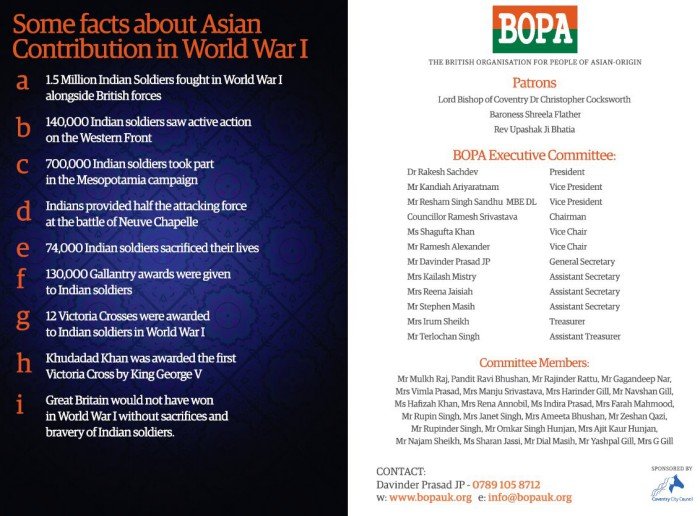
Summary:
British Indian Forces have fought & Died in 19 Countries in World War 1
Europe: in France, Belgium, Germany, Greece, Italy - Malta, Romania and some graves of the Sikhs (Pilots and wounded) are also in the United Kingdom.
Africa: Kenya and Tanzania.
Asia: Hong Kong, India and Turkey.
Middle East: Egypt, Iran, Iraq, Israel, Lebanon, Palestine, Syria.
In Europe during WW-1, it fought in Belgium-Flanders at Ypres twice from 22 October 1914 till 31 October 1914 and from 22 April 1915 till 1st of May 1915 and in France at La Bassee, and Neuve Chapelle from 10 to 13 marches 1915, Auber's Ridge, Festubert, Loos 25 September 1915, Givenchy and Somme from July 1916 to November 1916, thus fighting 7 Battles in France and 2 in Belgium.
In the First World War, the strength of the British Indian Army rose to 1, 6 million in 1918 with Sikhs as the major force, nearly 33 %.
There are 15,519 Burial place ( Smaads ) of the British Indian soldiers and 64,963 are commemorated by Memorial thus total of 80,482 have died in Ist World War (1914-18) according to the register of Common Wealth War Grave Commission.
Basra Memorial, Iraq has the largest 33,367 British Indian soldiers Commemoration by Memorial followed by Delhi Memorial, India Gate (12,321), Neuve Chapelle Memorial, France (5015)
Amara (Left Bank) Indian War Cemetery, Iraq has the largest Burials (Smaads) of British Indian soldiers (5000) followed by Baghdad (North Gate) War Cemetery (2513) and Mazargues War Cemetery, France (1002)
Total died in 1st World War (1914-1918) = 80,482. This is according to the register of CWGC record.
Commonwealth and British Indian Army Contribution in both World Wars.
The forces of British India played a major role in both World Wars. Nearly 1,700,000 men and women of the Commonwealth including some 169,700 from the forces of undivided British India died in the 1914-18 and 1939-45 Wars.
Total who died in both World Wars are: 80,482 + 89,218 = 1,69,700. Besides this, more than quarter of a million were wounded, ill, or prisoners of war. This is according to the register of CWGC record.
10 Victoria Cross has been won by British India Force In World War 1 and 18 in World War 2, thus total of 28 Victoria Cross have been won in both World Wars,
Bhupinder Singh Holland, In Ramgarhia Sikh Gurdwara, Coventry who addressed the Sangat on 18-01-2015 and was honored with Saropa.
Almere, The Netherlands. Dated 17-01-2015
<><><><><>
| Feedback from Dignitaries and Guests - BOPA Conference "Asian Contribution in WW1"
Mr Bhupinder Singh Holland - Guest Speaker from Holland Paul Sabapathy CBE, HM Lord- Lieutenant Mr. Warwick Hawkins: Department of Culture, Media & Sports Colonel Richard Mayberry, Deputy Commander, 11 Signal & WM Brigade Col George Marsh Mr David Burbidge OBE DL Chairman of DL Ambassadors Group for Coventry Many thanks for allowing us a slot to talk about the Coventry and Warwickshire City of Culture bid. I much look forward to working with BOPA to enhance the cultural life of our Asian community. I will initially make contact with Dr Rakesh Sachdev. Miss Panna A. Vekaria - Assistant General Secretary, Hindu Forum of Britain Ruth Evans, BBC Reporter Ms Randhir Auluck, Principal Lecturer, Coventry University Jitey Samra - Ekta-Unity-Asian-Ladies- Group Jyanti Panchal Brahama Kumaris Mr Steven Masih International Indian Christian Front Nasir Awan - A leading member of Muslim Business Community, Birmingham Mrs Surinder Nagra - Senior Manager in Coventry City Council Mr Mulkh Raj - Coventry community Mrs Farah Mahmood - Education professional from Coventry Adult Education |

